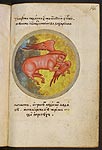Tetraevangelion.
Middle of 16th cent. Veliky Novgorod(?)
O (178 ı 119). 310 leaves.
paper. Ink, cinnabar, colours, gold.
It is written in a semi-uncial hand.
The illumination of the manuscript includes four Evangelist portraits (fols. 11v, 93v, 146v, 230v), four miniatures showing symbols of the Evangelists (fols. 11r, 93r, 146r, 230r). There are head-pieces in the Early Printed style (fols. 13r, 95r, 148r, 232r, 290r). Headings of the Gospels are written in cinnabar with use of ligatures.
A high level of craftsmanship of artists and the professional calligraphy is an evidence that the Gospel may have been created in one of the workshops of Veliky Novgorod (Novgorod the Great). Several artists - miniaturists illuminated the codex. The decoration of the Four Gospels is surprisingly various. Each Gospel is preceded by a leaf depicting a symbol of the Evangelist, on reverse side of the leaf is a canonical image of the Evangelist, followed by guard plates with cloth insets. Luxurious head-pieces and initialýs with gold precedes the beginnings of the Gospels. Roundels containing symbols of the Evangelists on a gold background, are placed on single leaves. This iconographic feature is rather rare to be found in decoration of old Russian manuscripts. Such tradition can be traced back to the Khitrovo Gospeldating fron the early 15th century. (–√¡, Ù. 304, 8657).
In 1919 the manuscript came into the State Public Library along with the collection of the Solovetsky Monastery.
Shelfmark: –Õ¡. —ÓÎ. 144/144.





